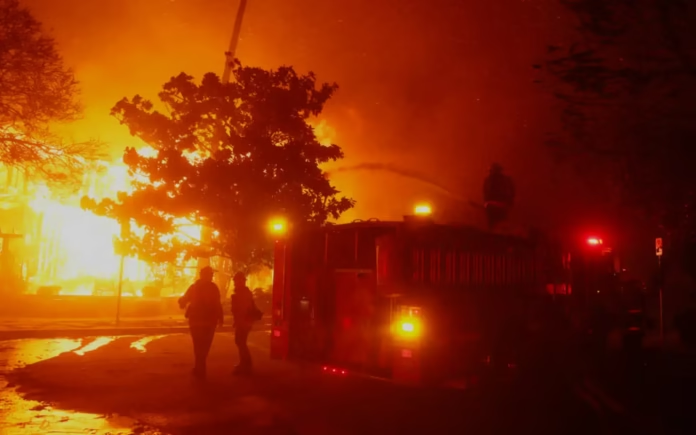According to the South Coast Air Quality Management District, potential direct smoke impact from the Palisades Wildfire burning has caused unhealthy air quality in Los Angeles County. Smoke from the Palisades Fire is expected to most heavily impact northwest coastal Los Angeles County including Malibu, Pacific Palisades and areas near the fire. This advisory remains in effect through 5 p.m., Jan. 8. Smoke impacts will depend on fire activity, containment efforts, and the weather. For more information about the Palisades Fire, visit CALFIRE.
Wildfire smoke is a mixture of small particles, gases and water vapor. The primary health concern is the small particles, which can cause burning eyes, runny nose, scratchy throat, headaches and illness (i.e., bronchitis). People at higher risk, children, the elderly, those with respiratory or heart conditions, and people with compromised immune systems, may experience more severe effects such as difficulty breathing, wheezing, coughing, fatigue, and/or chest pain.
Public Health urges everyone in areas where there is visible smoke or the smell of smoke or unhealthy air quality to avoid unnecessary outdoor exposure and to limit physical exertion (whether indoor or outdoor), such as exercise. Children, older adults, and people who are pregnant or have other air quality sensitive conditions, such as heart disease, asthma, and other chronic respiratory diseases, should follow these recommendations and stay indoors as much as possible even in areas where smoke, soot, or ash cannot be seen or there is no smell of smoke. If your condition worsens, contact your health care provider immediately for medical advice.
You can also follow the California Department of Education’s Memo: Get Smart about Wildfire Smoke – Clear Guidelines for Schools and Wildfire Smoke or the California Environmental Protection Agency’s Guidance for Schools During Wildfire Smoke Events, based on the air quality level in your area.
People can participate in indoor sports or other strenuous activity in areas with visible smoke, soot, or ash, provided the indoor location has air conditioning that does not draw air from the outside and it has closed windows and doors to protect the cleanliness of indoor air. If not, it is recommended that everyone follow the guidelines as if they were outside.
The following recommendations will help you protect yourself and your family from harmful effects of bad air quality:
If you see or smell smoke, or notice particles and ash in the air, stay indoors to limit exposure, especially if you have heart or lung conditions, are elderly, or have children.
Keep indoor air clean by closing windows and doors. Use air conditioners that recirculate air to filter out harmful particles. Wear an N95 or P100 mask if you must go outside in smoky conditions for long periods of time in areas with heavy smoke or where ash is present.
Avoid air conditioners that only bring in outside air and don’t recirculate. Check and replace air filters regularly. Filters labeled “MERV13” or higher are most effective for removing smoke particles. HEPA air purifiers can further reduce indoor particles.
If it’s too hot to keep windows and doors closed and you don’t have an air conditioner, go to a public place like a library or shopping center to stay cool and protect yourself from harmful air.
Avoid using fireplaces, candles, or vacuums. Clean dusty surfaces with a damp cloth and don’t smoke.
If you experience symptoms like severe coughing, shortness of breath, wheezing, chest pain, palpitations, nausea, or unusual fatigue, contact your doctor or go to urgent care. For life-threatening symptoms, call 911.
When smoke lingers, fine particles may build up indoors even if you can’t see them. Masks can protect against larger particles, but most don’t block fine particles or toxic gases, which are more harmful.
Practice safe clean-up following a fire. Follow the ash clean-up and food safety instructions at http://bit.ly/SafeFireCleanup.
The following is recommended for pets:
Avoid leaving your pets outdoors, particularly at night. Pets should be brought into an indoor location, such as an enclosed garage or a house.
If dogs or cats appear to be in respiratory distress, they should be taken to an animal hospital immediately. Symptoms of respiratory distress for dogs include panting and/or an inability to catch their breath. Symptoms for cats are less noticeable, but may include panting and/or an inability to catch their breath.
To stay updated with real-time/forecasted Air Quality in your area, download the South Coast AQMD Mobile App: http://www.aqmd.gov/mobileapp (Also available in Spanish!) or visit https://www.aqmd.gov/home/air-quality/air-quality-forecasts.



